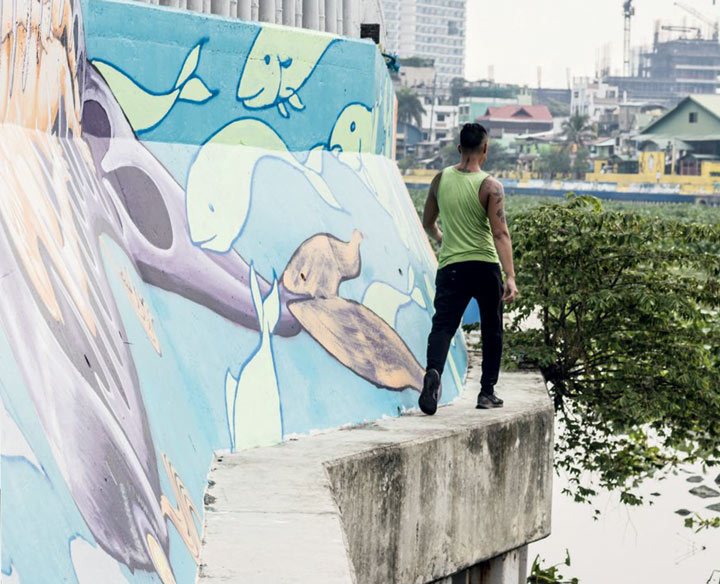With the success of his previous works that draw attention to the rehabilitation of the Pasig River, the artist continues to use his skills to further the vision.
READ ALSO: LA Exclusive: Pinto Art Museum’s Former Curator Explains His Explosive Black Saturday Post
Three years ago, Pasig River Art for Urban Change was launched through a partnership between the British Council and the Metropolitan Manila Development Authority (MMDA). A floating performance garden—made possible via a Burning Man Global Arts grant—and nine painted pumping stations after, Leeroy New shows no signs of resting any time soon.
Flowing content
Since last September, you can catch the multi-talented artist traversing the narrow walkways along the riverbank on some days of the week, painting under the heat of the sun. In vibrant colors that effectively draw the eye to his riverside canvas even from several yards away, New calmly paints a variety of surrealist images, sweat dripping from his forehead. It was a humid afternoon, and the unforgiving rays made it more of a challenge.
Regardless, he was in good spirits, sharing a joke or two and gamely posing for our photographer taking his pictures from across the other side of the river.
“The content of the art is the river,” New says, referring to the assigned transects painted by the art collective. Either the artists respond to it or provide alternative images to contrast and complement the river, he explains. “Some draw directly from the river, like the forms.”
Art advocacy
On his own mural, fish and other sea creatures of varying shapes, sizes, colors, and degrees of manipulation abound. New narrates several mythologies concerning bodies of water ranging from the supernatural to the dark and mysterious. His interpretation is bedecked with meaning, and each spontaneous stroke is a decisive paragraph to his personal narrative.
The project is laced with well-meaning advocacy, and goes against the grain of the public perception on his craft. It is his mission to show that art, in many ways, is inclusive.
“My choice to do public works was a political choice, a statement against doing works in art-sanctioned spaces that don’t necessarily work for the Filipino people,” New explains, pointing to how galleries and museum remain out-of-touch with the masses.
“So as an art student back then, these were the conversations that we had. ‘What are the alternatives?’ ‘How can we come up with an alternative way to present our works that speaks to the community, that speaks to the people?’ Andami ring different ways of addressing it and solutions. We just try to give our time,” he says.
Cultural identity
Reminiscing the early days of the initiative, New shares how this is their team’s way of growing the vision he shared with Julia Nebrija, who was then-MMDA assistant general manager for operations. Since the beginning, it was their intention to reclaim the Pasig River as a cultural and historical site, drawing attention to its social significance.
Of course, at the end of the day, New tells us, it is still the urban planners, scientists, and environmentalists doing the bulk of work in the local government’s initiative to bring the river back to its former glory.
“Art and design strategies are just the first part of it,” he says. “One of the main intentions was to get more people to ride the ferry system. And one way to do that was injecting a cultural identity to the riverside. It could be an art historical tour. In other countries, rivers that cross through the city are very well utilized.”

Around 30 artists responded to the call for the initiative. As part of the curatorial committee, New was involved in selecting the team, partnering artists to work and collaborate, and assigning them their art spaces.
The result is an immersive experience where artists and communities converse, with such engagement producing visual tales that resonate with the local communities in one way or another. Each artist is given free rein to illustrate their stories, some interacting with the local communities for contextual reference.
This, New explains, allows them to explore different approaches and methodologies in completing these creative interventions. “It’s really for the love of the vision,” he says.
Meaningful exchange
The assistants that help them are locals, he shares. “To me, it’s not just so much for them as for the artists. You have to pick out artists from the bubble of their studios. It’s two-way,” New says. “My interactions with them inform me as much as my presence here shows them how I do my work. I’m kinda performing for them as well.”
Several locals watch New while he continues painting. Separated by his imagination and concentrating on the fine details, he pulls back and offers the team to join him.
As I nervously work on what the artist tells me is a dorsal fin, he gives more insight into his personal experience. “These exchanges matter to me… I don’t know with them,” he says with a chuckle. “Some artists interview them and ask what they want them to paint. It’s a good opportunity to present alternative experiences for the community.”
Resting briefly for a cigarette, New gazes at the stretch of the river in deep thought. And as if to break from the mental pause, he concludes our conversation with the same level of solemn optimism as when we started.
“The fact that this intersection happened is already a feat,” New says, referring to the community-shared experience. “Who knows where this will lead?” And with that, he picks up his brush and returns to his artful duty.
Banner Photo by Lloyd Jhocson of Studio 100





